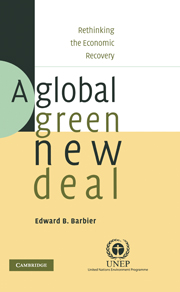Book contents
- Frontmatter
- Contents
- List of figures
- List of tables
- List of boxes
- Foreword
- Preface
- Acknowledgements
- Part I Why a Global Green New Deal?
- Part II The Key Components of a Global Green New Deal
- Part III The Role of the International Community
- Part IV Towards a Greener World Economy
- 10 Summary of recommendations
- 11 Will a Global Green New Deal succeed?
- 12 Beyond a green economic recovery
- Appendix 1 PIIE–WRI analysis of a green recovery program for the United States
- Appendix 2 Pew comparative analysis of clean energy jobs and investments in the United States, 1998–2007
- Glossary
- Index
- References
11 - Will a Global Green New Deal succeed?
Published online by Cambridge University Press: 05 June 2012
- Frontmatter
- Contents
- List of figures
- List of tables
- List of boxes
- Foreword
- Preface
- Acknowledgements
- Part I Why a Global Green New Deal?
- Part II The Key Components of a Global Green New Deal
- Part III The Role of the International Community
- Part IV Towards a Greener World Economy
- 10 Summary of recommendations
- 11 Will a Global Green New Deal succeed?
- 12 Beyond a green economic recovery
- Appendix 1 PIIE–WRI analysis of a green recovery program for the United States
- Appendix 2 Pew comparative analysis of clean energy jobs and investments in the United States, 1998–2007
- Glossary
- Index
- References
Summary
As noted throughout this book, any Global Green New Deal should have three principal purposes:
reviving the world economy, creating employment opportunities and protecting vulnerable groups;
reducing carbon dependency, ecosystem degradation and water scarcity; and
furthering the Millennium Development Goal of ending extreme world poverty by 2025.
To achieve these multiple objectives, a comprehensive range of national and international actions were proposed in parts II and III, which have been summarized in the previous chapter.
Fulfilling these recommendations will require a range of further initiatives, including commitments to increased public investments, new pricing policies, improving regulations, more aid disbursements and other policy changes. The need for such sweeping policy commitments inevitably raises questions about whether a Global Green New Deal will succeed.
In particular, three concerns have been expressed about the additional green fiscal stimulus measures and other public spending advocated by the GGND.
What is the evidence that the investments in the “green” economic sectors advocated by the GGND will create more employment and profits compared to conventional fiscal stimulus spending?
If the green sector investments are so economically advantageous, why is the private sector not making the necessary investments already?
Would additional green stimulus add to the unease about government debt and its inflationary consequences, as well as the problem of structural imbalances in the world economy?
- Type
- Chapter
- Information
- A Global Green New DealRethinking the Economic Recovery, pp. 217 - 257Publisher: Cambridge University PressPrint publication year: 2010



